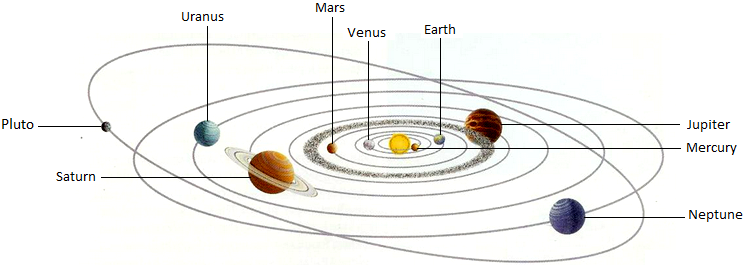Orbits of the Planets
We will discuss about the orbits of the planets. There are nine planets of the sun. They maintain their respective distances from the sun. They do not cross each other as they revolve around the sun remaining in their own orbits.
On the basis of their nearness to the sun they are Mercury, Venus, Earth, Mars, Jupiter, Saturn, Uranus, Neptune and Pluto.
The nearest planet to the sun is Mercury and the farthest, Pluto.
The largest planet is Jupiter. Then come Saturn, Uranus, Neptune, Earth, Venus, Mars, Mercury and Pluto in the descending order.
The four inner planets Mercury, Venus, Earth and Mars – which are closer to the Sun, are made up of rocks and iron.
Mercury
is the nearest planet to the Sun and it is very hot during the day and very
cold at night. It has no moons. There is very little air around mercury.
Venus is the hottest planet. It shines the brightest among all planets. It can be seen in the morning or evening. It is often called the morning or the evening star. Venus also does not have any moon.
Earth is the only planet that has life. It is neither too hot nor too cold. It has water and is surrounded by air containing oxygen.
Mars is known as the red planet. It appears red because of the red dust that covers it. It has two moons.
The outer planets are Jupiter, Saturn, Uranus, Neptune and Pluto. These planets are further away from the Sun. They are very cold and mainly consist of frozen gases.
Jupiter is
the largest planet. It has 16 known moons. It has a big red spot on it. This is
actually a huge storm which has been blowing for years.
Saturn is the second largest planet. It has 7 wide rings that surround it. It has 7 wide rings that surround it. It has 18 known moons.
Uranus is the third largest planet. It has 15 known moons.
Neptune has 8 known moons. Two spots can be seen on its surface. These are actually storms with very fast blowing winds.
Pluto is the smallest planet.
From Orbits of the Planets to HOME PAGE
Recent Articles
-
Amphibolic Pathway | Definition | Examples | Pentose Phosphate Pathway
Jun 06, 24 10:40 AM
Definition of amphibolic pathway- Amphibolic pathway is a biochemical pathway where anabolism and catabolism are both combined together. Examples of amphibolic pathway- there are different biochemical… -
Respiratory Balance Sheet | TCA Cycle | ATP Consumption Process
Feb 18, 24 01:56 PM
The major component that produced during the photosynthesis is Glucose which is further metabolised by the different metabolic pathways like glycolysis, Krebs cycle, TCA cycle and produces energy whic… -
Electron Transport System and Oxidative Phosphorylation | ETC |Diagram
Feb 04, 24 01:57 PM
It is also called ETC. Electron transfer means the process where one electron relocates from one atom to the other atom. Definition of electron transport chain - The biological process where a chains… -
Tricarboxylic Acid Cycle | Krebs Cycle | Steps | End Products |Diagram
Jan 28, 24 12:39 PM
This is a type of process which execute in a cyclical form and final common pathway for oxidation of Carbohydrates fat protein through which acetyl coenzyme a or acetyl CoA is completely oxidised to c… -
Aerobic Respiration | Definition of Aerobic Respiration | Glycolysis
Dec 15, 23 08:42 AM
This is a type of respiration where molecular free oxygen is used as the final acceptor and it is observed in cell. Site of Aerobic Respiration - Aerobic respiration is observed in most of the eukaryo…





New! Comments
Have your say about what you just read! Leave me a comment in the box below.